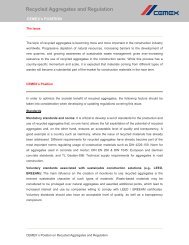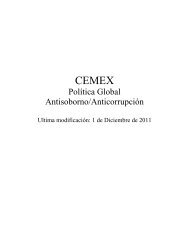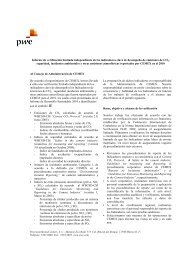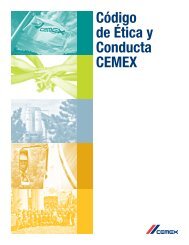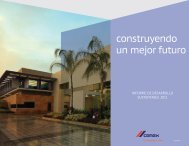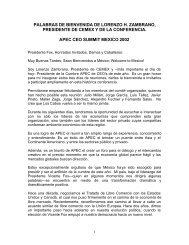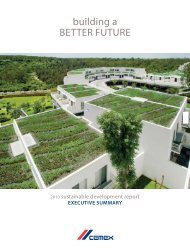building a STRONGER foundation - Cemex
building a STRONGER foundation - Cemex
building a STRONGER foundation - Cemex
Create successful ePaper yourself
Turn your PDF publications into a flip-book with our unique Google optimized e-Paper software.
In addition, we are one of the world’s largest suppliers of aggregates, primarily hard rock, sand and gravel, obtained from<br />
quarries, to be used in ready mix concrete and other concrete-based products such as blocks and pipes.<br />
Customers use our aggregates for a wide array of purposes, from a key component in the construction and maintenance of<br />
highways, walkways, and railways to an indispensable ingredient in concrete, asphalt and mortar. Aggregates can be used in their<br />
natural state or crushed into smaller size pieces.<br />
The types of mine mostly used to extract raw materials for aggregates and cement production, are open pit or open cut, which<br />
relate to deposits of economically useful minerals or rocks that are found near the land surface. Open-pit mines that produce raw<br />
material for our industry are commonly referred to as quarries. Open-pit mines are typically enlarged until either the mineral resource<br />
is exhausted, or an increasing ratio of overburden to exploitable material makes further mining uneconomic. In some cases, we also<br />
extract raw materials by dredging underwater deposits.<br />
Aggregates and other raw materials for our own production processes are obtained mainly from our own sources. However, we<br />
may cover our aggregates and other raw material needs through the supply from third-parties. For the year ended December 31, 2010,<br />
approximately 11% of our total raw material needs were supplied by third-parties.<br />
Reserves are considered as proven when all legal and environmental conditions have been met and permits have been granted.<br />
Proven reserves are those for which (i) the quantity is computed from dimensions revealed by drill data, together with other direct and<br />
measurable observations such as outcrops, trenches and quarry faces and (ii) the grade and/or quality are computed from the results of<br />
detailed sampling; and the sampling and measurement data are spaced so closely and the geologic character is so well defined that<br />
size, shape, depth and mineral content of reserves are well-established. Probable reserves are those for which quantity and grade<br />
and/or quality are computed from information similar to that used from proven reserves, but the sites for inspection, sampling, and<br />
measurement are farther apart or are otherwise less adequately spaced. The degree of assurance, although lower than that for proven<br />
reserves, is high enough to assume continuity between points of observation.<br />
Our reserve estimates are prepared by CEMEX’s engineers and geologists and are subject to annual review by our corporate<br />
staff jointly with the regional technical managers associated to our business units. On specific circumstances we have used the services<br />
of third-party geologists and/or engineers to validate our own estimates. Over the three-year period ended December 31, 2010, we<br />
have employed third-parties (i) to review our cement raw materials reserves estimates in the United Kingdom, Germany, Croatia,<br />
Poland, Latvia, Philippines, Thailand and Puerto Rico, and (ii) to review our aggregates reserves estimates in Spain, Germany, France,<br />
Poland, Latvia, Austria, Czech Republic, Croatia, Hungary, Egypt, Israel, Malaysia, Panama and Nicaragua.<br />
Reserves determination incorporates only materials meeting specific quality requirements. For aggregates used in ready mix<br />
concrete such requirements are based on hardness, shape and size; for cement raw materials (mainly limestone and clay), such<br />
requirements are based on a chemical composition that matches the quality demanded by the production process. In the case of cement<br />
raw materials, since chemical composition varies from production sites and even in the same site, we conduct geostatistical chemical<br />
tests and determine the best blending proportions to meet production quality criteria and to try to maintain an extraction ratio close to<br />
100% of the reported reserves for such materials.<br />
The main equipment utilized in our production sites is as follows:<br />
In our cement facilities: drills, crushers, kilns, coolers, mills, packing/loading machines, pay loaders, excavators, off-road<br />
trucks and other material handling equipment.<br />
In our ready-mix concrete facilities: batch plants, silos and mobile equipment and mixer trucks.<br />
In our aggregates facilities: drills, crushers, screens, belt conveyors, pay loaders, excavators, trucks and other material<br />
handling equipment.<br />
We believe that our facilities are in general good condition, adequate for efficient operations.<br />
During 2010, our total quarry material production was approximately 210 million tons, of which approximately 62% was used<br />
for own consumption to produce cement, ready-mix concrete, and/or other products which are later sold to the public and the<br />
remaining 38% was directly sold to customers.<br />
Our estimates distinguish between owned and leased reserves, the later determined over the term of the lease contract, and<br />
include only those permitted reserves which are proven and probable. As of December 31, 2010, the total surface of property in our<br />
quarries operations (including cement raw materials quarries and aggregates quarries), was approximately 109,380 hectares, of which<br />
approximately 73% was owned by us and approximately 27% was managed through lease contracts.<br />
35



